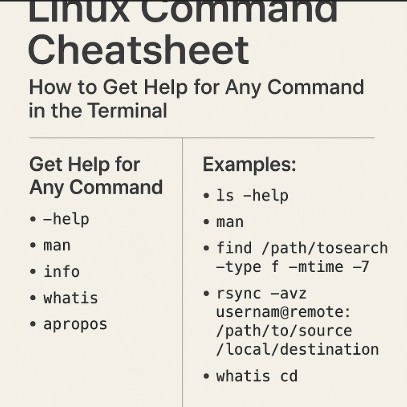Table of Contents
- 1 Introduction: Unlock the Power of Linux Commands
- 2 What is a Linux Command Cheatsheet?
- 3 How to Get Help for Any Command in the Linux Terminal
- 4 Practical Examples of Using Linux Command Cheatsheet
- 5 Advanced Examples: Using Complex Linux Commands
- 6 FAQ Section: Frequently Asked Questions
- 7 External Resources:
- 8 Conclusion: Mastering Linux Command Help
Introduction: Unlock the Power of Linux Commands
The Linux command line is a powerful tool that gives users complete control over their systems. Whether you’re managing a server, automating tasks, or simply trying to get work done faster, knowing how to navigate and execute commands in the terminal is essential. However, with thousands of commands and options, it can sometimes feel overwhelming. That’s where a cheatsheet can come in handy. This article will guide you through how to get help for any command in the Linux terminal, from basic queries to advanced features, and how to maximize your productivity with command-line tools.
What is a Linux Command Cheatsheet?
A Linux command cheatsheet is essentially a quick reference guide that helps users efficiently execute commands in the terminal. The cheatsheet can show syntax, options, and examples for specific commands. Rather than memorizing every command, you can rely on this helpful tool to look up necessary information in an instant.
But how do you get this help in the first place? In Linux, there are built-in tools that allow you to look up help for almost any command.
How to Get Help for Any Command in the Linux Terminal
Linux offers several methods to access help for commands. Let’s explore the different approaches:
1. Using –help for Quick Information
The simplest way to get help for any Linux command is to append --help to the command. This provides a concise overview of the command’s usage, options, and examples.
Example: Using ls –help
If you want to understand how the ls command works (used to list directory contents), you can run the following command:
ls --help
This will display the available options, such as -l for long listing format, -a for including hidden files, and many others.
2. Using man (Manual Pages) for Detailed Help
For more detailed information, you can use the man command, which stands for “manual.” This command opens a detailed manual for any command, including its syntax, options, descriptions, and even examples.
Example: Using man ls
To view the manual for the ls command, run:
man ls
This will bring up a page that explains every option and feature available in ls. You can navigate through the man pages using the arrow keys, search with /, and quit by pressing q.
3. The info Command: Another Way to Explore Commands
Another helpful tool for getting in-depth information about commands is info. This command provides access to detailed documentation for a command, usually in a more structured format compared to the man pages.
Example: Using info ls
info ls
This will show you detailed, well-organized information about the ls command.
4. Using the whatis Command for Quick Descriptions
If you only need a short description of a command, you can use the whatis command. This provides a one-line summary of a command’s functionality.
Example: Using whatis ls
whatis ls
Output:
ls (1) - list directory contents
This is perfect for when you just need a quick refresher on what a command does.
5. Using apropos for Searching Commands
If you’re unsure about the exact name of a command but know the general idea of what it does, you can use apropos. This command searches through the manual pages for commands related to a keyword or phrase.
Example: Searching for File Commands
apropos file
This will return a list of commands related to files, such as ls, cp, mv, and many others, helping you find the right one for your task.
Practical Examples of Using Linux Command Cheatsheet
Let’s dive into some practical examples of how to get help using the methods mentioned above. We will use some common Linux commands to demonstrate.
Example 1: grep Command
The grep command is used for searching text using patterns. Let’s look at how to get help using the methods above.
- Quick Help:
grep --help- This will show you basic usage and available options for the
grepcommand.
- Manual:
man grep
- Info Page:
info grep
- Whatis:
whatis grep
Example 2: cd Command (Change Directory)
The cd command is one of the most basic commands used to change directories in the terminal. However, it’s useful to know how to access its documentation.
- Quick Help:
cd --help
- Manual:
man cd
- Whatis:
whatis cd
Advanced Examples: Using Complex Linux Commands
In addition to basic commands, Linux provides powerful commands with multiple options. Let’s explore some more advanced examples where you can use the help tools.
Example 3: find – Searching Files
The find command allows you to search for files in your system based on various criteria, such as name, size, or modification date.
Example: Using find to Search for Recently Modified Files
find /path/to/search -type f -mtime -7
This searches for files in /path/to/search modified within the last 7 days.
- Quick Help:
find --help
- Manual:
man find
- Info Page:
info find
Example 4: rsync – Backup and Synchronization
rsync is a powerful tool for backing up and synchronizing files across directories or remote servers.
Example: Sync Files from a Remote Server
rsync -avz username@remote:/path/to/source /local/destination
- Quick Help:
rsync --help
- Manual:
man rsync
- Info Page:
info rsync
Example 5: awk – Text Processing
awk is a powerful text-processing tool used for extracting and manipulating data.
Example: Extracting Columns from a CSV File
awk -F, '{print $1, $2}' employees.csv
- Quick Help:
awk --help
- Manual:
man awk
- Info Page:
info awk
Example 6: sed – Stream Editor for Text Manipulation
sed is a stream editor for transforming text in files or input streams.
Example: Replacing Text in a File
sed -i 's/apple/orange/g' filename.txt
- Quick Help:
sed --help
- Manual:
man sed
- Info Page:
info sed
Example 7: curl – Web Data Retrieval
curl is a command-line tool for transferring data to or from a server, using various protocols.
Example: Sending an HTTP GET Request
curl -X GET https://api.example.com/data
- Quick Help:
curl --help
- Manual:
man curl
- Info Page:
info curl
FAQ Section: Frequently Asked Questions
1. What is the difference between man and info?
While both man and info provide documentation, man typically displays information in a simpler, page-by-page format. On the other hand, info provides a more detailed and structured format, making it easier to navigate complex documentation.
2. How do I exit from a man page or info page?
To exit from a man or info page, simply press q to quit.
3. What if I can’t find help for a command?
If you can’t find help using man, info, or whatis, it could be that the command doesn’t have any documentation installed. You can try installing the manual pages for that command using your package manager (e.g., apt-get install manpages for Debian-based distributions).
4. Are there any other ways to get help with Linux commands?
Yes! You can also check online resources, forums, and communities like Stack Overflow and the Linux documentation project for help with specific commands.
External Resources:

Conclusion: Mastering Linux Command Help
Navigating the vast world of Linux commands doesn’t have to be intimidating. By using built-in tools like --help, man, info, whatis, and apropos, you can easily get the information you need for any command in the terminal. Whether you’re a beginner or an experienced user, knowing how to access these resources quickly can drastically improve your workflow and help you become more proficient with Linux.
By leveraging the tips in this guide, you can gain a deeper understanding of the commands at your disposal and confidently explore the Linux command line. Keep your Linux command cheatsheet handy, and with practice, you’ll be able to master the terminal like a pro!Thank you for reading the DevopsRoles page!

